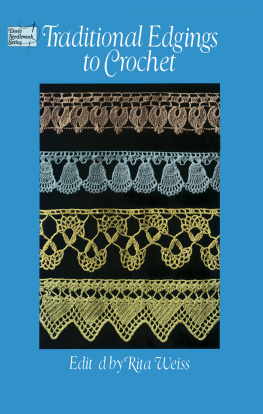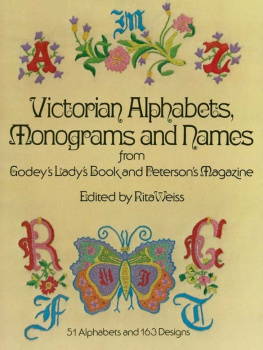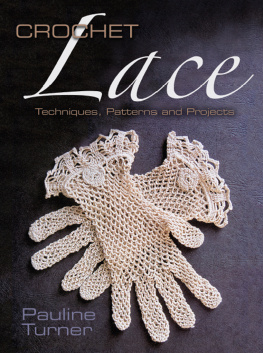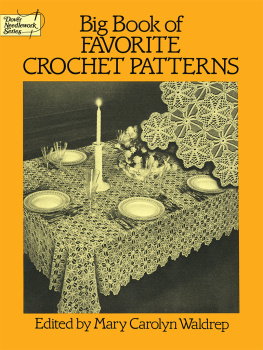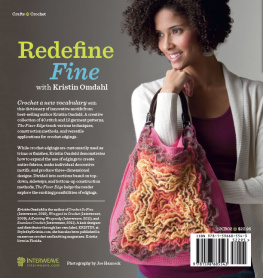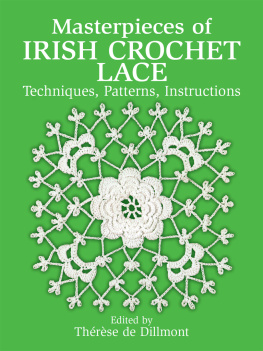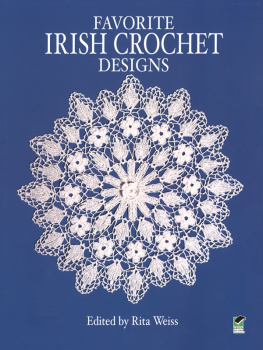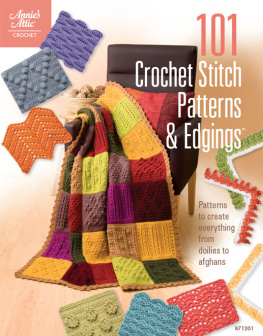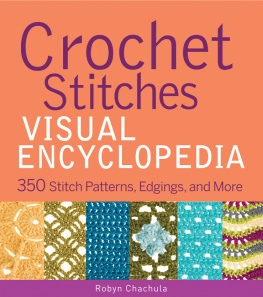Traditional Edgings To Crochet
Edited by
RITA WEISS

Dover Publications, Inc., New York
CROCHET ABBREVIATIONS
| ch | chain |
| sc | single crochet |
| half dc | half double crochet |
| tr | treble |
| d tr | double treble |
| sl st | slip stitch |
| pc st | popcorn stitch |
| sp | space |
| st(s) | stitch(es) |
| rnd | round |
| incl | inclusive |
| inc | increase |
| dec | decrease |
*(asterisk) or (dagger) Repeat the instructions following the asterisk or dagger as many times as specified.
** or Used for a second set of repeats within one set of instructions.
Repeat instructions in parentheses as many times as specified. For example: (Ch 5, sc in next sc) 5 times means to make all that is in parentheses 5 times in all.
Copyright 1987 by Dover Publications, Inc.
All rights reserved.
This Dover edition, first published in 1987, is a new selection of patterns from Star Book of 100 Edgings: Crocheted, Tatted, Knitted. Book 18, published by the American Thread Company, New York, in 1942; Edgings for All Purposes Including Church Laces, Book No. 320, published by Coats & Clark, Inc., New York, in 1956; Decorating with Crochet, Direction Book 1800, published by the Lily Mills Co., Shelby, N.C., in 1948; Crochet and Tatting, Heirloom Edition, Star Book No. 66, published by the American Thread Company in 1949; Floral Insertions and Floral Edgings, Book No. 263, published by The Spool Cotton Company, New York, in 1949; Handkerchief Edgings, Book No. 311, published by Coats & Clark, Inc., in 1955; and Edgings, Book No. 8, published by Royal Society, Inc., in 1947. A new introduction has been specially written for this edition.
Library of Congress Cataloging-in-Publication Data
Traditional edgings to crochet.
(Dover needlework series)
Reprinted from thread-company leaflets originally published 1942-1956.
1. CrochetingPatterns. I. Weiss, Rita. II. Series.
TT825.T73 1986 746.434041 86-19637
eISBN 13: 978-0-486-16281-2
Manufactured in the United States by Courier Corporation
25238809
www.doverpublications.com
Contents
Introduction
For years crocheters have been fascinated with crocheted edgings. If they had no time to make a tablecloth or even a doily, they could still personalize any item by simply adding a handmade crocheted edging.
This collection contains some of the best crocheted edging patterns that have appeared in instructional booklets published by Americas thread companies during the first part of this century. During that period, hundreds of instructional booklets were created as a device for selling more thread. Among the most popular of the patterns published were those for crocheted edgings. Many of these old instructional booklets and the edgings they inspired have now become collectors items. Modern technology permits us to show the patterns to you exactly as they originally appeared.
Many of the patterns make no suggestion for thread or hook size since the size of the thread determines the width and texture of the edging; very fine threads create finer lace while coarser threads produce heavier edgings. shows the same edging pattern worked in various weights of thread and suggests the proper hook for each thread. Finer threads require a finer hook; a heavier hook is used with heavier threads. You may want to experiment with different weights of thread and sizes of hooks to determine your favorite lace.
Edgings that are crocheted the long way are worked on a foundation chain or directly on the fabric. Those worked on a foundation chain can be cut, if necessary, to obtain the desired length. Cut at the end of the complete pattern; fasten the loose threads at the ends of rows, and hem or overcast the cut edge.
Edgings crocheted the short way are easier to do than those crocheted the long way because they can be worked to the exact length required.
When you have completed your edging, wash and block it. Wash in warm water with a good neutral soap or detergent, squeezing the suds through the work. Rinse in clear water. Starching the edging will give it a crisper look and add body. Using rustproof pins, pin the edging right side down on a well-padded surface. Be sure to pin out all picots, loops, scallops, etc. When the edging is almost completely dry, press through a damp cloth with a moderately hot iron. Do not rest the iron on the decorative, raised stitches! When thoroughly dry, remove the pins.
The crochet terminology and hooks listed in this book are those used in the United States. The following charts give the U.S. name of crochet stitches and their equivalent in other countries and the equivalents to U.S. crochet hook sizes. Crocheters should become thoroughly familiar with the differences in both crochet terms and hook sizes before starting any project.
All of the stitches used in the edgings in this book are explained on .
STITCH CONVERSION CHART
| U.S. Name | Equivalent |
| Chain | Chain |
| Slip | Single crochet |
| Single crochet | Double crochet |
| Half-double or short-double crochet | Half-treble crochet |
| Double crochet | Treble crochet |
| Treble crochet | Double-treble crochet |
| Double-treble crochet | Treble-treble crochet |
| Treble-treble or long-treble crochet | Quadruple-treble crochet |
| Afghan stitch | Tricot crochet |
HOOK CONVERSION CHART
Aluminum

Steel


Delicate Edgings
Materials Suggested AMERICAN THREAD COMPANY STAR or GEM MERCERIZED CROCHET COTTON Sizes 30 to 70 or STAR TATTING COTTON
No. 1807
Ch 11, d c in 7th st from hook, ch 3, skip 3 chs, d c in end ch, ch 6, turn.
2nd Row. D c in 1st mesh, ch 3, d c in next mesh, ch 5, turn.
3rd Row. D c in 1st mesh, ch 3, 10 d c in next mesh, d c in next mesh, ch 3, turn.
4th Row. S c in next d c, * ch 3, skip 1 d c, s c in next d c, repeat from * twice, ch 4, d c in next mesh, ch 3, d c in end mesh, ch 5, turn.
5th Row. D c in 1st mesh, ch 3, d c in next mesh, ch b, turn.
6th Row. D c in 1st mesh, ch 3, d c in next mesh, ch 5, turn.
7th Row. D c in 1st mesh, ch 3, 10 d c in next mesh, d c in next mesh, ch 3, turn and repeat from 4th row for length desired.
No. 1808
Ch 5, d c in 1st ch, ch 3, 2 d c in top of d c just made, ch 3, sl st in same space, * ch 3, 2 d c in same space, ch 3, sl st in same space, repeat from *, d c in 1st ch, ch 3, s c in same space, ** ch 11, d c in 5th st from hook, ch 3, d c in top of d c just made, sl st in side petal of 1st clover, d c in same space, ch 3, sl st in same space and complete clover same as 1st clover, repeat from ** for length desired.
Next page
